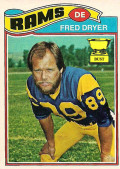8th Circuit Appears Divided in Dryer v. NFL Oral Arguments
By Jennifer E. RothmanOctober 27, 2015

The oral arguments from last Thursday’s hearing before the 8th Circuit in Dryer highlight a host of flashpoints in right of publicity law. The arguments focused on whether the use of historical film clips constituted commercial speech. The plaintiffs’ attorney claimed that the use by the NFL was clearly commercial speech and therefore not entitled to First Amendment protections, citing the 7th Circuit decision in Jordan v. Jewel Food Stores (2014). In Jordan, however, the parties had conceded that the commercial speech question decided whether there was any First Amendment protection in the context of a Lanham Act claim and the appellate court expressed rightful skepticism of that conclusion. The oral arguments here highlight the confusion over how to categorize and distinguish commercial speech from for-profit commercial uses, like films, news, and sports broadcasts, as well as marketing for the same. The plaintiff is correct that the broadcasts in Dryer undoubtedly drive good feelings and income to the NFL through game attendance, merchandise, and its entertainment and broadcast programming, and related advertising revenue. This, however, does not make the broadcasts commercial speech, nor does it remove First Amendment protection even if it is commercial speech.
The second right of publicity flashpoint addressed was copyright preemption and whether the players’ agreement to appear in the underlying sporting events prevented subsequent right of publicity claims arising out of a derivative work using those broadcasts. The defense attorney distinguished the uses at issue from using a player’s image on a coffee mug, because in such an instance the likeness of the player would be extracted from the underlying copyrighted work and repurposed. Under copyright law this is a difference without meaning, although the argument may otherwise seem appealing and perhaps has more traction in a conflict preemption analysis then a section 301 analysis.
The final right of publicity conundrum addressed in oral arguments was the scope of the newsworthiness defense and what counts as newsworthy under the various state laws at issue. One judge on the panel questioned whether an old football game counted as “newsworthy.” Such a narrow interpretation of what is newsworthy would be catastrophic for documentarians, journalists, and other creators who often delve into past events. The arguments also touched upon the question of whether the demonstration via survey evidence of some possible confusion was enough to overcome judgment as a matter of law on the false endorsement Lanham Act claim. The full arguments can be heard here – Oral Arguments, Dryer v. NFL, Oct. 22, 2015 (8th Cir.)
